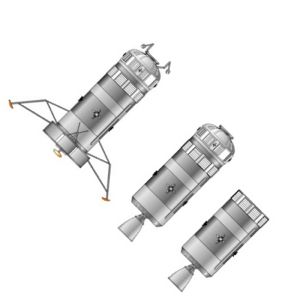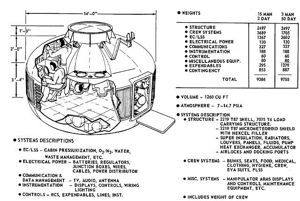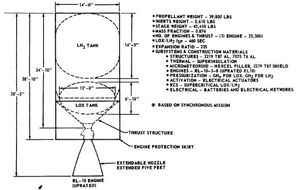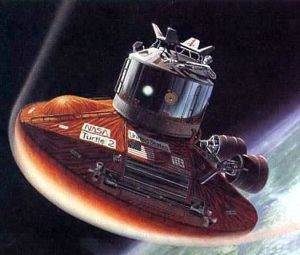
Home - Search - Browse - Alphabetic Index: 0- 1- 2- 3- 4- 5- 6- 7- 8- 9
A- B- C- D- E- F- G- H- I- J- K- L- M- N- O- P- Q- R- S- T- U- V- W- X- Y- Z
Space Tug
 Space Tug Credit: © Mark Wade |
Status: Design 1974. Thrust: 99.14 kN (22,288 lbf). Gross mass: 20,600 kg (45,400 lb). Unfuelled mass: 2,550 kg (5,620 lb). Specific impulse: 460 s. Height: 10.80 m (35.40 ft). Diameter: 4.27 m (14.00 ft).
The Tug could be outfitted with a variety of kits to serve in many roles, including as a manned lunar lander. Aerobraking for recovery in low earth orbit was considered for further study, but the baseline used RL10 engines to brake into earth orbit for refurbishment and refueling at a space station. All further work was cancelled by NASA in 1972, but resurrected as the aerobraking Orbital Transfer Vehicle in the 1980's.
Space Tug Systems had to be compatible for both utilization as (1) upper stages and payload components for the Saturn V vehicle and its derivatives and (2) as upper stages and payload components for the Earth-to-Orbit Shuttle (EOS). Primary applications for the Space Tug/Saturn V Systems would be for transportation of large payloads to lunar orbit and interplanetary missions. The Space Tug systems would be utilized as payload components for the above missions when used in conjunction with the nuclear shuttle. The majority of the Space Tug missions would, however, be in conjunction with the EOS. The baseline EOS considered for selection of the compatible Space Tug inventory was one with a 4.57 m diameter by 18.29 m long cargo bay. The maximum capability of this baseline EOS was specified as 24,500 kg to a 28 deg 185 km circular earth orbit. Later EOS design criteria, however, established the EOS capability to the 185 km. 28-1/2 deg inclination orbit at 29,500 kg. This larger EOS would allow utilization of a larger Tug propulsion module. The study had shown that the desirability of a larger propulsion module was generally questionable unless the size could be increased to on the order of 40,900 kg. However, if the aerobraking mode was proven feasible, this larger EOS capability could allow either placement or retrieval of 4500 kg of payload to or from geosynchronous orbit with a single EOS launch.
Considering the overall mission requirements and the required compatibility of the Space Tug with the other elements of the Space Transportation System, an inventory of Space Tug elements was selected. This inventory could accomplish, when assembled into the proper configurations, the overall mission spectrum. The selected Tug inventory consisted of the following components:
- Primary propulsion modules with a 18,000 kg propellant capacity (designed for earth orbit missions).
- Expendable drop tanks with 18,000 kg propellant capacity.
- Secondary propulsion modules with a 7,600 kg propellant capacity (designed for earth orbit missions).
- Astrionics modules (designed for earth orbit missions).
- All purpose crew modules (outfitted as required for the various missions).
- Cargo modules which use the shell of the all-purpose crew module.
- Doughnut cargo modules (to carry experiments for the manned lunar landing missions).
- Kits as follows:
- Payload retrieval and placement adapters
- A manipulator arm kit.
- Staging adapters and separation mechanisms.
- Clustering adapters (to provide for clustering of propulsion modules).
- Plug-in astrionics for specific mission requirements.
- Insulation and micrometeoroid kits (for increasing the thermal and micrometeoroid protection of the primary propulsion modules for the extended time of lunar landing missions}.
- Reaction Control System Booster Kit (to increase the reaction control system thrust for the lunar landing mode}.
- A landing leg kit (for lunar landing).
- Radar kit for lunar landing.
- Auxiliary power supply kit (for lunar surface operations. )
The primary propulsion module was designed for earth orbit and planetary missions. This module would use LOX/LH 2 propellant at a nominal mixture ratio, by weight, of 5 to 1, LOX to LH2. The primary thrust would be provided by an uprated RL-10 engine which would provide a maximum thrust of 10,600 kgf at a specific impulse of 460 seconds. The engine was throttleable over a range of from 10 percent maximum thrust to maximum thrust. It was equipped with an extendible nozzle section which could be retracted 1.6 m to minimize length for transport in the EOS or to minimize the interstage length when tandem stages were required or desired. Utilization of this stage for lunar missions would require application of increased insulation and micrometeoroid shielding; a reaction control system booster kit; and auxiliary power kit; and a landing leg kit.
Expendable drop tanks for very high energy missions would be desirable to minimize the size of the required Space Tug configuration. The expendable drop tank consisted of the same tankage arrangement and pressurization systems as that of the primary module. The insulation was the same as that provided to the primary propulsion module. The items deleted from the primary propulsion module to provide drop tanks include the reaction control system, engine, reaction control system, thrust structure, electrical actuation system for engine gimballing and some of the micrometeoroid protection systems.
The Space Tug's basic characteristics included:
Primary Propulsion Module (45,000 lbs Weight)
- Propellant Weight - 39,800 lbs
- Inert Weight - 5,610 lbs
- Stage Weight - 45,410 lbs
- Mass Fraction - 0.876
- (1) Engine - 23,300 lbs thrust
- Lox/LH2 Isp - 460 Sec
- Expansion Ratio - 225
- Subsystems & Construction Materials
- Structures - 2219 T87 Al, 7075 T6 Al
- Thermal - Superinsulation
- Micrometeoroid - Hexcel Filler, 2219 T87 Shield
- Engines - Rl-10-3-8 (Uprated Rl10)
- Pressurization - Gaseous Helium for Lox; Gaseous Hydrogen For LH2
- Activation - Electrical Actuators
- RCS - Supercritical Lox/LH2
- Electrical - Batteries And Electrical Networks
Drop Tank Module
- Propellant Weight 39,800 lbs
- Inert Weight 4,090 lbs
- Stage Weight 43,890 lbs
- Mass Fraction 0.906
- Lox/LH2 Isp 460 Sec
- Subsystems
- Structures - 2219 T87 Al (Tanks) 7075 T6 (Load Structure)
- Thermal - Superinsulation
- Micrometeoroid - Hexcel Filler, 2219 T87 Shield
- Pressurization - GHe For Lox, Gh2 For Lh2
- Electrical - Batteries And Electrical Network
- Drop Tank Feed System - 7075 T6 Lines
Family: Space Tugs. Country: USA. Engines: RL-10A-3A. Launch Vehicles: Proton-K, Space Shuttle. Propellants: Lox/LH2. Agency: NASA, Boeing. Bibliography: 2665, 6916.
 | Tugcrew Credit: NASA |
 | Space Tug Credit: NASA |
Back to top of page
Home - Search - Browse - Alphabetic Index: 0- 1- 2- 3- 4- 5- 6- 7- 8- 9
A- B- C- D- E- F- G- H- I- J- K- L- M- N- O- P- Q- R- S- T- U- V- W- X- Y- Z
© 1997-2019 Mark Wade - Contact
© / Conditions for Use
